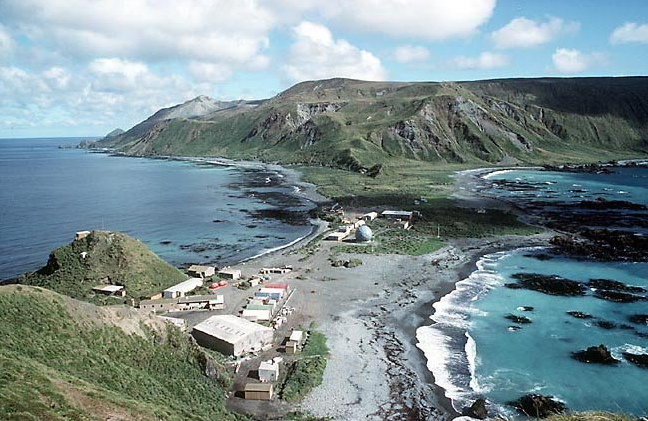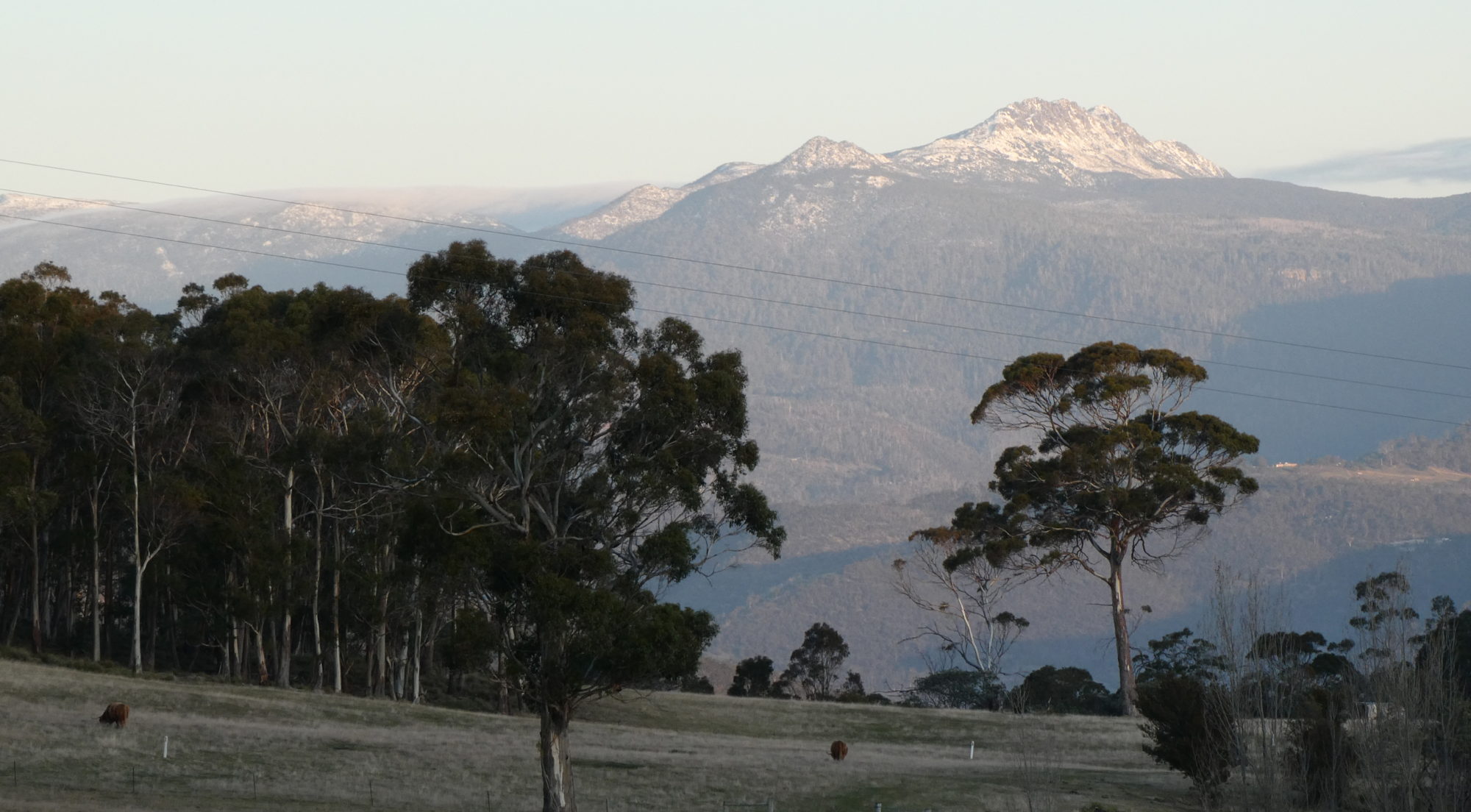
You see new things
John Reid
We arrived at Buckles Bay, Macquarie Island on MV Nella Dan in December 1963. We clambered down the ship’s side on a rope ladder into an army DUKW (pronounced “duck” – an army amphibious landing craft) and were driven ashore. As the vehicle ground its way up the steep pebble beach I recall not being overly impressed by my new surroundings. Four ton elephant seals clashed their chests in mock battle and needed to be persuaded to get out of the way of our vehicle. Despite the brisk, cold wind whipping through the tussock grass the place stank to high heaven. The smell came mainly from the piles of rotting bull kelp strewn along the beaches. This was going to be my home for the next 12 months. It did not look, or smell, very hospitable.
The southern aurora (Aurora Australis) is most active at the latitude of Macquarie Island which lies 1200 km SE of Tasmania, Australia. There is a band of activity known as the Auroral Oval which is centred on the South Magnetic Pole located at the edge of Antarctica due south of Tasmania. I had taken a job with the Australian Antarctic Division as Auroral Physicist. This entailed operating various semi-automatic instruments which measured various aspects of the aurora. Fortunately long nights of visual observation were no longer part of the job description. There was an “all-sky-camera” which took a 10 second exposure (at 1200 ASA) of the whole sky once per minute during the hours of darkness, a spectrophotometer which measured auroral colours and an instrument called a “riometer” (for “relative ionospheric opacity meter”) which was destined to play a big part in my professional life.
All of this high-tech gear was new. I was one of the first of a new breed of auroral physicists being sent south. First we had to build the auroral lab, then install the new gear, and then get it working. The prefabricated lab was erected just over the summit of Camp Hill to keep the instruments away from stray light.
I spent the whole year in a frantic attempt to keep it all operational. The station experienced frequent power failures due to contaminated diesel fuel and these led, in turn, to failures in the lab DC power supply which supplied all the instruments. Solid state electronics was very new back then. I had barely even seen a transistor before I arrived. Eventually I redesigned the lab power supply to make it sufficiently robust to handle the successive power failures and brown outs. I also developed about 5 km of 35 mm all-sky-camera film.
It was a hectic year but I coped and in the end stayed on an extra 3 months to show the new guy the ropes. I had very little time to do any “research” per se; I was, in effect, a maintenance technician. Meanwhile this wild an windy place had got into my blood. One stormy night I had a vivid Jungian dream in which I was a Viking and which I still remember. In some way, I grew up there.
The place teemed with wild life. Several species of penguin, fur seals and elephant seals, skuas, giant petrels and other sea birds were all to be found within the main base at Buckles Bay at the northern end of the island.
Further afield, various sorts of albatross nested. The wandering albatross nesting on the coastal plain could be approached without attempting flight. They are the world’s largest flying bird, so large that they can only become airborne with difficulty. Another albatross, the incredibly beautiful, light-mantled sooty albatross, nested among the giant grass tussocks which completely covered the steep slopes. Occasionally, on the plateau among cushion plants and rocks, a feral cat would be glimpsed from afar. They were larger than domestic cats and generally ginger in colour.
On the coastal plains of grass and featherbed bog were rabbits and wekas. The Stewart Island weka is a flightless rail similar to the kiwi and introduced by the sealers. The wekas were amusing little creatures, like fluffy, chestnut brown bantams. They occupied small territories with fiercely contested, but imaginary, boundary lines. On the beaches and around the base numerous fat elephant seals were moulting, mating or fighting, depending on the time of the year. It was like living in a big zoo.
The riometer is really a radio telescope with a very wide beam antenna pointing upwards and operating at the lowest frequency at which the ionosphere is transparent and does not reflect distant radio stations (~30 MHz). It receives radio noise from the Milky Way passing overhead once every sidereal day, giving a long smooth curve on the paper charts. When an aurora is overhead, radio waves are absorbed and big dips appear in the usually smooth, daily curve. It was a very reliable and sensitive instrument and, unlike optical methods, operated equally well in daylight and on cloudy nights. After I returned to Australia in March 1965 I continued to work at the Antarctic Division in Melbourne. I became interested in the fine structure of the riometer absorption records. It was very tantalizing; certain rough or “noisy” patches seemed to correspond to the X-ray “microbursts” which had recently been observed by the University of Tasmania Physics Department team’s high altitude balloons. The trouble was the riometer did not have enough resolution to isolate the individual pulses; what was needed was a faster riometer.
I had previously commenced a PhD at the Uni of Tas, Physics Department on another topic. My supervisor, Prof G.R.A. (Bill) Ellis, was, fortuitously, a low-frequency radio astronomer. I told him about my idea for a fast riometer and he graciously allowed me to resume my PhD with this new topic.
In late 1966 I returned to Macquarie Island with the world’s first operational “fast-response-riometer” designed using a state-of-the-art, low-noise radio receiver developed at the University of Tasmania. It had 50 times the resolution of a conventional riometer. I constructed an antenna out of copper wire, ceramic insulators and bean poles.
On site I developed a calibrator, housed in an Edgeworth tobacco tin bolted to the front of the rack mount. This was a source of great mirth to the other post-graduate student, an American with very fancy-looking equipment. Over the next three months I recorded the first observations of cosmic noise absorption pulsations. Their slow exponential decay provided a window into electron-ion recombination in the D-region, 80 km above the earth. I returned home in March 1967 and published my discovery in a Letter to Nature.

I returned to Macquarie during the summers of 1968 and 1969 when I determined the spatial size and shape of the pulsations using new antennas, some of which were designed on-site. Later on I was able to show that another auroral-zone phenomenon, Pi1 micropulsations, were due to the same underlying mechanism.
This was all, of course, entirely useless; the purest of pure research. There was no practical reason for studying the ionosphere following the advent of communication satellites. No one today has the slightest interest in cosmic noise absorption pulsations nor in Pi1 micropulsations apart from a few researchers in closely related fields. This may change if there is a nuclear war and the issue of EMP (electromagnetic pulse) becomes important, in which case D-region behaviour may suddenly become relevant once again.
However I learned a lot. I learned how important it is to have instruments that work properly and are properly calibrated, whatever they may look like. I learned that science is not about plugging a computer into the Universe and pressing the ON button. It is about interacting with the real world; you have to manipulate things in order to understand them and you have to understand them in order to manipulate them. That is how understanding, the end-product of science, is built up. The idea that you can sit indoors at a computer terminal and determine how the real world must work is nonsense.
Mostly I remember what Bill Ellis told me before I went South with my gear. He said:
When you first use an instrument with much higher resolution than before, not only do you see the same things bigger, you see new things.
This is precisely what happened to Galileo. When he first looked at the planet Jupiter in 1610 he not only saw a sphere on a larger scale, he saw four of Jupiter’s moons as well. This, the first observation of planetary satellites, supported the new heliocentric theory and ultimately lead to the development of modern astronomy and physics.
When I operated my fast riometer for the first time, I too saw new things.


Thanks for this very interesting story, John. Agreeing with most of the points you make, but knowing nothing at all about the field, I thought I might try to accommodate it within the view of Science proposed in detail on page 2 of my essay on Reality. That differs from your view that “That is how understanding, the end-product of science, is built up.” Thinking freely about this has brought me to the wild surmise which follows
My notion of Science leads directly to a specific question, about what might reasonably be called aurora science, which, by now, fifty years on, should/might have a clear answer. Each of our many well-developed sciences, as I call them, has two aspects, both necessary, neither sufficient on its own. So, the science of Galileo, mentioned by John has/requires both the observational/experimental aspect enabled by Galileo’s telescope and the mathematical/proof aspect realised soon afterwards as Newton’s Laws.
[I need to say explicitly here, that my idea of a small “s” science works well, and is not impacted by the remarks below.]
After reading Wikipedia on Auroras and Cosmic Rays, I see that the idea/hope I had does not work. Aurora science is not a science in the narrow sense that Galileo’s was/is. And I almost see why.
What seems to work instead is the notion I attribute to Leibniz, of what I call monad sciences. Aurora science seems to be more like the account we might/should give of the unpredictable motions of a bird, attributing those motions to the free will of that individual.
This might makes a kind of sense now to Blackjayers who are openly speculating about the religious impulse that human beings seem to have.
As someone who was a confident atheist from age 14 to age (about!) 74 I come now to what at first sight is an outrageous idea. Might it be that the sun, which is the source of most of the particles that cause auroras may/can be well understood as a monad with free will, like an individual bird or an individual human being?
I’d like to know what John and other Blackjayers make of this wild idea.
[Nature Abstract, 1967:
“PULSATIONS have been observed in cosmic noise absorption at Macquarie Island (54.5° S., 158.95° E.). The pulsations lasted for 5–20 sec and extended to 0.4 dB in magnitude. They were usually non-sinusoidal and non-periodic and occurred in trains which lasted for 20 min to 2 h near local midnight.”]